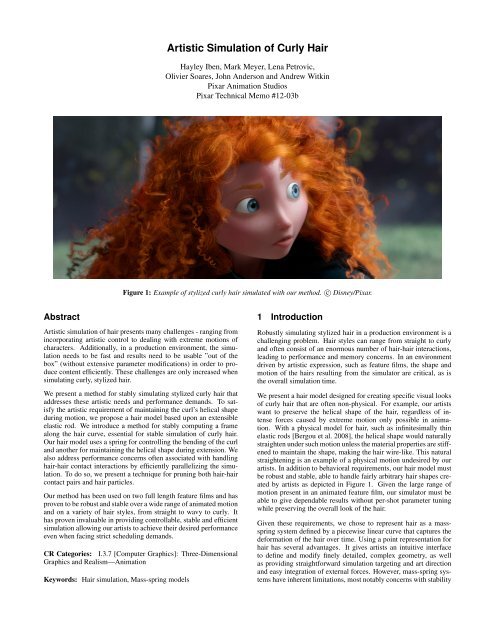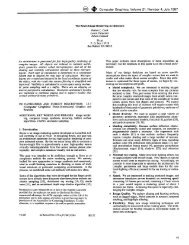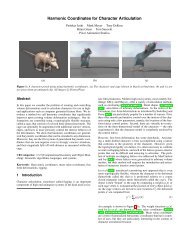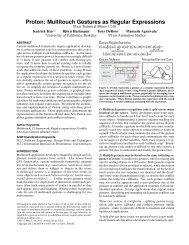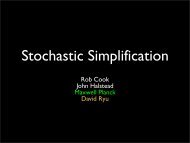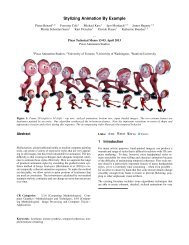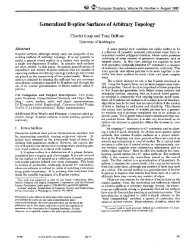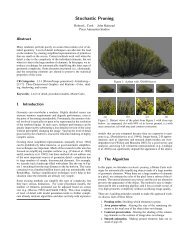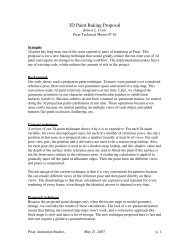Artistic Simulation of Curly Hair - Pixar Graphics Technologies
Artistic Simulation of Curly Hair - Pixar Graphics Technologies
Artistic Simulation of Curly Hair - Pixar Graphics Technologies
You also want an ePaper? Increase the reach of your titles
YUMPU automatically turns print PDFs into web optimized ePapers that Google loves.
<strong>Artistic</strong> <strong>Simulation</strong> <strong>of</strong> <strong>Curly</strong> <strong>Hair</strong>Hayley Iben, Mark Meyer, Lena Petrovic,Olivier Soares, John Anderson and Andrew Witkin<strong>Pixar</strong> Animation Studios<strong>Pixar</strong> Technical Memo #12-03bFigure 1: Example <strong>of</strong> stylized curly hair simulated with our method. c○ Disney/<strong>Pixar</strong>.Abstract<strong>Artistic</strong> simulation <strong>of</strong> hair presents many challenges - ranging fromincorporating artistic control to dealing with extreme motions <strong>of</strong>characters. Additionally, in a production environment, the simulationneeds to be fast and results need to be usable ”out <strong>of</strong> thebox” (without extensive parameter modifications) in order to producecontent efficiently. These challenges are only increased whensimulating curly, stylized hair.We present a method for stably simulating stylized curly hair thataddresses these artistic needs and performance demands. To satisfythe artistic requirement <strong>of</strong> maintaining the curl’s helical shapeduring motion, we propose a hair model based upon an extensibleelastic rod. We introduce a method for stably computing a framealong the hair curve, essential for stable simulation <strong>of</strong> curly hair.Our hair model uses a spring for controlling the bending <strong>of</strong> the curland another for maintaining the helical shape during extension. Wealso address performance concerns <strong>of</strong>ten associated with handlinghair-hair contact interactions by efficiently parallelizing the simulation.To do so, we present a technique for pruning both hair-haircontact pairs and hair particles.Our method has been used on two full length feature films and hasproven to be robust and stable over a wide range <strong>of</strong> animated motionand on a variety <strong>of</strong> hair styles, from straight to wavy to curly. Ithas proven invaluable in providing controllable, stable and efficientsimulation allowing our artists to achieve their desired performanceeven when facing strict scheduling demands.CR Categories: I.3.7 [Computer <strong>Graphics</strong>]: Three-Dimensional<strong>Graphics</strong> and Realism—AnimationKeywords: <strong>Hair</strong> simulation, Mass-spring models1 IntroductionRobustly simulating stylized hair in a production environment is achallenging problem. <strong>Hair</strong> styles can range from straight to curlyand <strong>of</strong>ten consist <strong>of</strong> an enormous number <strong>of</strong> hair-hair interactions,leading to performance and memory concerns. In an environmentdriven by artistic expression, such as feature films, the shape andmotion <strong>of</strong> the hairs resulting from the simulator are critical, as isthe overall simulation time.We present a hair model designed for creating specific visual looks<strong>of</strong> curly hair that are <strong>of</strong>ten non-physical. For example, our artistswant to preserve the helical shape <strong>of</strong> the hair, regardless <strong>of</strong> intenseforces caused by extreme motion only possible in animation.With a physical model for hair, such as infinitesimally thinelastic rods [Bergou et al. 2008], the helical shape would naturallystraighten under such motion unless the material properties are stiffenedto maintain the shape, making the hair wire-like. This naturalstraightening is an example <strong>of</strong> a physical motion undesired by ourartists. In addition to behavioral requirements, our hair model mustbe robust and stable, able to handle fairly arbitrary hair shapes createdby artists as depicted in Figure 1. Given the large range <strong>of</strong>motion present in an animated feature film, our simulator must beable to give dependable results without per-shot parameter tuningwhile preserving the overall look <strong>of</strong> the hair.Given these requirements, we chose to represent hair as a massspringsystem defined by a piecewise linear curve that captures thedeformation <strong>of</strong> the hair over time. Using a point representation forhair has several advantages. It gives artists an intuitive interfaceto define and modify finely detailed, complex geometry, as wellas providing straightforward simulation targeting and art directionand easy integration <strong>of</strong> external forces. However, mass-spring systemshave inherent limitations, most notably concerns with stability
p'2d 1d 2dd43p'p'p'd 0p'5p1e 1p12p354e 0e e 42ep0p3p3 4Elastic rods model (E = G = 8 × 10 9 )Figure 3: Original curve (bold line) with points p i and edges e ioverlaid with corresponding smoothed curve (thin blue line) withpoints p ′ i and edges defined by vectors d i.Our bending model (k b = 3 × 10 4 , c b = 1.74 × 10 3 )Figure 2: Simple example <strong>of</strong> a perfect helical curl undergoingmotion from the walk cycle <strong>of</strong> Figure 12. The elastic rod model (top)introduces rotation around the helix, apparent in the orientation <strong>of</strong>the end <strong>of</strong> the curl, while our bending model (bottom) does not.<strong>of</strong> curls (Section 3.3). These three springs comprise our per hairforce model.3.1 Stretch SpringWe define our hair model using a set <strong>of</strong> particle positions connectedby linear springs. Let each hair be defined by a set <strong>of</strong> current particlepositions P = {p 0, . . . , p N−1} and initial rest pose particles,¯P , where ¯· denotes rest quantities. Let the current velocities forthese particles be V = {v 0, . . . , v N−1} and the polyline edgesconnecting hair particles be e i = p i+1 − p i. We compute a standarddamped linear spring force on particle i byf s(k s, c s) i = k s(‖ e i ‖ − ‖ ē i ‖)ê i + c s(∆v i · ê i)ê i (1)where k s are the spring and c s the damping coefficients, ∆v i =v i+1 − v i, ‖ · ‖ denotes vector length and ˆ· vector normalization.Because springs in our model are connecting two particles, each<strong>of</strong> our spring forces is applied equally to both particles in oppositedirections.Our artists also want to enable bounce during a walk cycle, for example,by allowing hair to slightly stretch (see Figure 12 and thevideo for an example). To allow this artistic stretch <strong>of</strong> the hair withoutusing stiff springs, we impose an upper limit on the stretch <strong>of</strong>the polyline similar to the biased strain limiting approach presentedin [Selle et al. 2008]. During the spring damping calculation, werecurse from the root to the tip limiting the velocity <strong>of</strong> the hair particleif ∆vi2 exceeds a threshold. After we update positions, weagain recurse from the root <strong>of</strong> the hair to the tip shortening edgesthat exceed the specified stretch allowance. By using this limiter,artists are able to control the desired amount <strong>of</strong> stretch allowed bythe system.3.2 Bending SpringOur method to control bending is most similar to the elastic rodsmodel [Bergou et al. 2008; Bergou et al. 2010], which computesthe material frame as the minimizer <strong>of</strong> elastic energy <strong>of</strong> the curve.They use these material frames to compute the bending and twistingenergies along the rod. However, the formulation <strong>of</strong> Bergou et al.introduces rotation during simple motion <strong>of</strong> a curl, such as a walkcycle, shown in Figure 2 top. This rotation can be removed by! = 0 ! = 2 ! = 4 ! = 6 ! =∞Figure 4: Example <strong>of</strong> a stylized curly hair (far left) and thesmoothed curves (blue) computed with α at 2, 4, 6, and ∞.increasing the material’s stiffnesses, but this change leads to wirelikebehavior (see video).This type <strong>of</strong> rotation in the curl, while physically accurate, is undesirablefor our application. Our hair model instead introducesa method to stably generate the material frame by parallel transportingthe root frame <strong>of</strong> the hair along a smoothed piecewise linearcurve (see Section 3.2.1). The result <strong>of</strong> using our smoothedcurve is a series <strong>of</strong> frames that are not highly influenced by smallchanges in point positions, avoiding unwanted rotation as illustratedby Figure 2 bottom. Our bending formulation uses reference vectorsposed in the frames from the smoothed curve to compute thebending force (see Section 3.2.2).3.2.1 Smoothing FunctionLet Λ = {λ 0, . . . , λ N−1} be a set <strong>of</strong> N elements in R 3 associatedwith a hair, such as particle positions or velocities. We define oursmoothing function, d i = ς(Λ, α) i, with an infinite impulse response(IIR) Bessel filter (for examples, see [Najim 2006]). Thesefilters are recursive functions, combining the input and prior resultsto produce each new result.To compute the results, we take as input the smoothing amount,α ≥ 0, in units <strong>of</strong> length along the curve. Let β = min(1, 1 −exp(−l/α)) where l is the average rest length per segment <strong>of</strong> thehair being smoothed. We then recursively compute vectors d i ∀i ∈[0 . . . N − 2] with the equationd i = 2(1 − β)d i−1 − (1 − β) 2 d i−2 + β 2 (λ i+1 − λ i) . (2)By choosing these coefficients and initializing d −2 = d −1 = λ 1 −λ 0, this equation reduces to d 0 = λ 1 − λ 0 at i = 0. Subsequentd i values are weighted towards this initial direction, an importantproperty for our usage <strong>of</strong> this function.When Λ is a set <strong>of</strong> positions, we can reconstruct the smoothed polylineby recursively adding the vectors from the fixed root position.The new points, p ′ i ∀i ∈ [1 . . . N − 1], are defined byp ′ i = p ′ i−1 + d i−1 (3)where p ′ 0 = λ 0, the root <strong>of</strong> the polyline. We show the relationshipbetween an original and smoothed curve in Figure 3.
p'i-1p'iF i-1pi-1pi+1pi-1-b ipipipie ip'i-1F i-1p'ie ipi+1t ip'i-1p'ipi-1pi+1pi-1b ib ipip'i-1p'ipi+1t ip'i+1p'i+1t ip'i+1p'i+1Rest curvesPosed curvesRest curvesPosed curvesFigure 5: We precompute the rest edge ē i (left) and store it in thelocal frame ¯F i−1 (shown at ¯p ′ i for illustration) giving the referencevector ¯t i. We use the current pose’s local frame F i−1 (right) tocompute t i, our target bending direction, from ¯t i. Bold black linesrepresent the hair, thin blue lines represent the smoothed curve.The range <strong>of</strong> input values α = [0, ∞] produces well behaved outputfrom Equation 2. If α = 0, then we set β = 1, meaning thatd i = λ i+1 − λ i and no smoothing occurs. As α → ∞, thenβ → 0 and d 0 = · · · = d N−2 = λ 1 − λ 0. If this limit case occurswhen Λ is a set <strong>of</strong> positions, the polyline resulting from Equation 3is straight and in the direction <strong>of</strong> the first segment, regardless <strong>of</strong>how kinked the input polyline. Figure 4 gives an example curvefrom the model depicted in Figure 1 and the resulting smooth curvewith different α values.3.2.2 Bending Spring FormulationWe implement a bending spring force to stably control the bendbetween the rest and current poses <strong>of</strong> the hair while maintaining thehelical shape <strong>of</strong> curls. During initialization, we use the rest posepoints to precompute a reference vector, ¯t i = ¯F i−1ē Ti, as the edgeē i expressed in the local frame, ¯F i−1, <strong>of</strong> point ¯p i−1. We store theaxes <strong>of</strong> the frame as the columns <strong>of</strong> ¯F i−1 and use ē i as a columnvector. We compute the local frames, ¯F i−1, by parallel transport<strong>of</strong> the root rest frame, ¯F 0, along the smoothed curve defined byς( ¯P , α b ) with α b bending smoothing amount (see Figure 5 left).We use the common approach <strong>of</strong> rooting hair to a planar scalp polygon,which provides the animated motion for the hair and the hair’sroot coordinate frame, F 0. At each step <strong>of</strong> the simulation, we computeF 0 from the current root polygon and F i−1 from parallel transport<strong>of</strong> F 0 along ς(P, α b ). We use these local frames to stably posethe stored reference vectors ¯t i in the current hair configuration. Theresulting vectors are the target vectors, t i = F i−1¯t i, that we wantour current pose to match, as illustrated in Figure 5 right. We add aspring force between the edge in the current pose, e i, and the targetvector, t i, to obtain the bending forcef b (k b , c b ) i = k b (e i − t i) + c b (∆v i − (∆v i · ê i)ê i) (4)where k b is the spring and c b the damping coefficients. To providemore flexibility, we allow artists to specify the spring coefficientsfor each edge. This bending formulation preserves linear momentumbut not angular momentum. We could extend the model to alsopreserve angular momentum but have found it unnecessary for ourapplication.3.3 Core SpringUsing only stretch and bending springs was insufficient for ourartists’ needs when simulating curly hair over a variety <strong>of</strong> motions.A mass-spring model with stiff stretch and bending springs can holdthe curly shape during fast motion, but it reduces the ability forFigure 6: We precompute the rest core directions ¯b i (left) that weuse to compute the spring force and apply in the current pose, inthe direction −b i (right).the hair to bend. If we instead reduce the stiffness <strong>of</strong> the bendingsprings to allow flexibility, the curls lose shape and unwind at highaccelerations. Animated characters commonly undergo extreme accelerations(10x or more than that <strong>of</strong> gravity). The resulting curlunwinds becoming nearly straight and appears much longer thanthe desired look, even though there is minimal stretch. Althoughsuch behavior is physically correct, this curl unwinding is undesiredbehavior for our artistic needs. To allow flexible curly hairyet maintain shape, we introduce a third core spring that controlsthe longitudinal stretch <strong>of</strong> the curls without stiffening the bendingsprings. See Figure 10 and the accompanying video for examples.Similar to the bending calculation, we create a smoothed representation<strong>of</strong> the hair using the function described in Section 3.2.1. Weprecompute the representation <strong>of</strong> the original core <strong>of</strong> the curl fromthe rest points, ¯b i = ς( ¯P , α c) i, where α c is the smoothing amountfor core springs (see Figure 6 left). The resulting piecewise linearcurve represents the direction <strong>of</strong> the center <strong>of</strong> the curl, givinga more natural representation to control its longitudinal stretch, asillustrated by Figure 3.During the force calculation, we use the current hair pose to computeb i = ς(P, α c) i (see Figure 6 right). We apply the samesmoothing to the velocities to obtain the vectors ν i = ς(V, α c) ifor the spring damping term. We compute the core spring force bycalculating the amount <strong>of</strong> stretch along the core, giving the forcef c(k c, c c) i = k c(‖ b i ‖ − ‖ ¯b i ‖)ˆb i + c c(ν i · ˆb i)ˆb i (5)where k c is the spring and c c the damping coefficients. To maintainstability, we must keep k c < k s where k s is the spring coefficientmaintaining the connection between hair particles from Equation 1.Because this spring is intended to control longitudinal stretching,we avoid adding unnecessary constraints by allowing the core tocompress. We set the spring coefficient k c to zero during compression,determined from the spring length (‖ b i ‖ − ‖ ¯b i ‖). Weblend from zero to its full value upon extension to avoid a largeforce introduction using a cubic Hermite blending function. Sincethe segments <strong>of</strong> our hairs are approximately 1 unit in length, wefound that blending over the parametric domain [0, 0.5] is sufficient.During extreme motion (see Figure 10 and the video), a large corestiffness value is required to keep curls from unwinding. However,tuning k c for this extreme motion would undesirably stiffen thecurl’s shape during normal motion, such as a character’s walk cycle.To balance the artist’s desire for bounce during the walk cycle andcontrol during extreme motion, we nonlinearly change k c from thecurrent value to a maximum specified stiffness using a cubic Hermiteblending function based upon the amount <strong>of</strong> longitudinal curl
p0p r 01p r 12pr 23p r 3 4p0p r 01p2pr 23p4h 1< h 1, h 2>< h 1, h 3>< h 2, h 3>h 2h 3h 1h 2h 3P 1h 4h 5h 9h 8h 10h 6h 7h 11h 12P 2r 4r 4Before pruningAfter pruningP 3Figure 7: Each particle ¯p i has an associated sphere with radius r i(left). We prune particles contained in overlapping spheres (right)to reduce the number <strong>of</strong> potential contacts.stretch. We compute the blend weight from the ratio <strong>of</strong> the totallength <strong>of</strong> the current curve, b, to the total length <strong>of</strong> the rest curve,¯b. By automatically adjusting the core stiffness and damping, weavoid the need for per-shot parameter tuning.4 <strong>Hair</strong>-<strong>Hair</strong> ContactsIn addition to modeling a single hair, we must also model hair-haircontacts so that we can capture the interesting interactions whensimulating a mass <strong>of</strong> hair. If we were to consider every possiblepair <strong>of</strong> particles for interaction, the algorithm would become quiteexpensive. Instead, we reduce the number <strong>of</strong> interactions consideredby performing two kinds <strong>of</strong> pruning, enabling us to parallelizeour hair simulation and improve performance.We prune contact points along the hair, as described in Section 4.1.We also prune hair pairs allowed to interact during the simulationbased on the observation that for visually palusible complex hairinteraction we <strong>of</strong>ten do not need to model every individual interaction,only the aggregate effect. This pruning, described in Section4.2, enables us to parallelize our simulation and optimize thecommunication pattern between processors.We could have alternatively used a bounding hierarchy to accuratelyhandle contacts in all situations. The advantage <strong>of</strong> our method oversuch hierarchies is that we can statically compute the processorcommunication pattern; otherwise, we would need to dynamicallyupdate the processor communication or exchange all hair data betweenprocessors. The disadvantage <strong>of</strong> our algorithm is that thecontacts may be incorrect in certain situations, such as when longhair is flipped from one side <strong>of</strong> the scalp to the other. For our productionneeds, we have run into few examples where this limitationhas caused artifacts. In these rare cases, we decrease pruning toguarantee the correct contacts.4.1 Pruning <strong>Hair</strong> ParticlesOur hair-hair contact model must account for volume betweenguide hairs, each representing several rendered hairs. We usespheres around individual hair particles to indicate the volume eachparticle represents. Increasing these sphere radii increases the volume<strong>of</strong> the hair. Because spheres <strong>of</strong> neighboring particles on thesame hair overlap, we can reduce particles used for contact testingby pruning those contained inside neighboring spheres (see Figure7 left). Even with hair motion, the spheres around neighboringparticles will provide enough contact for hair-hair interactions.Our pruning test starts at the root <strong>of</strong> the hair (j = 0), which wenever prune, and compares the sum <strong>of</strong> the edges ē i to the potentiallyoverlapping spheres. We set k = 1 and continue to increment kFigure 8: By pruning hair pairs (simple example on left), we reducethe overall number <strong>of</strong> edges in the larger contact graph C(right). This reduction enables us to cluster the graph into processorswith reduced communication cost between P 1, P 2, and P 3.until the following equation is satisfied:k−1Xi=j‖ ē i ‖ > s(r j + r k ) (6)where r j is the radius for the j th particle and s a parameter controllingparticle sparsity. We then prune all particles between j and k,set j = k, k = k + 1 and repeat the process until we have reachedthe end <strong>of</strong> the hair. This process controls how much overlap there isbetween the contact spheres after pruning. Setting s = 1 means thatspheres would just touch with no overlapping. We have found thata value <strong>of</strong> 0.75 provides a good balance between performance andaccuracy. The result is a subset <strong>of</strong> available particles for handlingcontacts, as illustrated in Figure 7 right.4.2 Pruning <strong>Hair</strong> Pairs<strong>Hair</strong>-hair contact models are used to represent forces such as staticcharge and friction among neighboring hairs. We have observedthat when many hairs interact in a complex manner, it is not necessaryto capture all <strong>of</strong> the individual hair-hair interactions in orderto produce a plausible, visually appealing result. In fact, we can ignorecertain hair-hair interactions and their effect will <strong>of</strong>ten be feltthrough similar or indirect interactions with neighboring hairs. Forexample, consider three hairs h 1, h 2 and h 3 that are aligned in arow, as in Figure 8 left. We can prune the interaction < h 1, h 3 >and assume that the effect <strong>of</strong> this interaction will happen throughcontacts between < h 1, h 2 > and < h 2, h 3 >. As the numbers<strong>of</strong> hairs increase, the effects <strong>of</strong> these individual hair-hair interactionbecome less important as we mainly see the aggregate effects<strong>of</strong> many hair-hair interactions. Using this observation, we havedeveloped an algorithm to prune hair pairs used for contact testing- effectively sampling the hair-hair interactions. This pruningallows us to reduce the number <strong>of</strong> necessary hair-hair contacts, reduceinterprocessor communication and more efficiently parallelizethe simulation.To indicate the hairs allowed to interact during simulation, we use agraph C where each node is a hair and an edge C(h i, h j) indicatesthat hairs h i and h j are allowed to interact. Initially a full graph,we statically prune our contact graph at initialization time as follows:First, we multiply each r i by a constant, r c, and compute andsum all contacts between spheres on hair i and hair j, calling thesum n i,j. We prune edges where n i,j < n t, a threshold indicatingthe minimum number <strong>of</strong> hair contacts required for interaction. Wealso stochastically prune graph edges based on our observation thatneighboring hairs will <strong>of</strong>ten handle the interactions. It is importantto note that we are pruning hair-hair interactions from the graph;we are not pruning the hairs themselves.
Once we have pruned our graph, we assign hairs to processors forparallelization. To optimize performance, we attempt to minimizethe data exchanged between processors by using a greedy graphclustering algorithm. We initially assign equal numbers <strong>of</strong> hairs toeach processor, creating a graph clustering. The goal is to reducethe communication cost, computed as the number <strong>of</strong> edges betweenthe processor groups, while maintaining equal workloads. To do so,we greedily swap hairs between processors if it reduces the communicationcost, iterating until we have reached a minimum, or haveexceeded a maximum number <strong>of</strong> swaps (see Figure 8, right). Thisfinal clustering allows us to send less information between processorsthan if we had simply used all contact pairs, leading to moreefficient parallelization. Note that we could use any algorithm forconstructing the hair adjacency graph as long as it produces goodcommunication patterns between processors.4.3 Contact Detection and ResponseAt each step <strong>of</strong> our simulation, we spatially subdivide our scene intoa uniform grid structure where we insert the hair particles availablefor contact. For each hair particle, we use the grid to retrieve neighboringhair particles for contact testing. We discard potential contactsprior to testing if their is no hair pair edge C(h i, h j) betweenthe hairs containing the particles.If the hair pair < h i, h j > has not been discarded, we detect contactswhen their spheres overlap, ‖ p i − p j ‖ < r i + r j. Similarto prior methods [Chang et al. 2002; Bando et al. 2003; Selle et al.2008], we handle interactions by applying a spring penalty forceand break contacts when particles surpass a distance threshold. Ourmethod dynamically creates contacts, similar to [Selle et al. 2008].However, we attach springs between particles instead <strong>of</strong> edges anddo not directly limit the overall number <strong>of</strong> allowed contacts. Instead,we have already limited our contacts through pruning particlesand hair pairs.To avoid instabilities <strong>of</strong>ten associated with penalty forces, such ashigh-frequency bouncing <strong>of</strong> the objects in contact, we adjust springconstants when the spring breaks using a method similar to [Changet al. 2002] but with some additions. We dynamically increase thespring stiffness during initial contact while using full damping toavoid a large spring impulse. As the spring breaks, we first decreasethe stiffness to zero followed by the damping. We allow the springconstants to reengage if the particle’s distance decreases before thespring breaks, so that the contacts do not pass through one another.5 Implementation DetailsWe integrate our forces using a nested semi-implicit Euler integrationscheme with fixed time steps. Although one could possibly useadaptive time stepping, we have found it unnecessary in practice.We detect collisions and contacts in our outer loop. Our first nestedloop (the force loop) integrates the hair model springs, collision andcontact forces, while a further nested loop (the damping loop) integratesthe hair model spring damping forces. Our algorithm can besummarized as follows:For each outer loop iteration:Detect Collision and ContactsFor each force loop iteration:Integrate Internal <strong>Hair</strong> Forces (Section 3)Integrate External ForcesHandle <strong>Hair</strong>-<strong>Hair</strong> and <strong>Hair</strong>-Object CollisionsFor each damping loop iteration:Integrate Damping ForcesUpdate PositionsExchange <strong>Hair</strong> Data Between ProcessorsFigure 9: Example <strong>of</strong> stylized curly hair. c○ Disney/<strong>Pixar</strong>.For all models except RedHead, the outer loop time step is0.00138883 seconds (24 frames per second with 30 outer loop stepsper frame), the first nested loop time step is 9.25887e-05 (15 forcesteps per outer step), and second nested loop time step is 9.25887e-06 (10 damping steps per force step). For RedHead, we cut the outertime step in half to 0.000694416 (60 outer steps per frame) to handlethe higher spring stiffnesses and used the same number <strong>of</strong> forceand damping steps given above (force loop: 15 steps, 4.62944e-05seconds per step; damping loop: 10 steps, 4.62944e-06 seconds perstep). After determining the time steps for the models, no additionaltime step tuning was needed during production shots as thisintegration scheme provided consistent and stable results.In our implementation, we use MPI for inter-processor communication.For hair-object collision detection, we spatially subdivide thescene into a uniform grid using a method similar to [Teschner et al.2003]. Our simulator uses penalty forces for collision response,a commonly used approach [Plante et al. 2002; Choe et al. 2005;Bertails et al. 2006; McAdams et al. 2009] that is fast to compute.However, our contributions do not rely on which collision modelwe use and an alternative method could be substituted.6 Results and DiscussionOur simulator has been used on two feature films with a variety <strong>of</strong>characters and hair styles. By creating a stable simulator, we areable to generate most simulations using our default character parameters(examples <strong>of</strong> the default parameters for our RedHead andHorse characters are given in Table 1). These parameters are tunedonce per character, starting from the appropriate default. Eliminatingper-shot parameter tweaking provides a dramatic benefit toproduction schedules and can have a great impact on the productionbudget. Although most <strong>of</strong> the shots (approximately 80%) are “out<strong>of</strong> the box”, our simulator provides additional controls and supportsexternal forces for artistic direction (a common use is to keep thecharacters’ hair from blocking their face).Effects <strong>of</strong> Bending Smoothing: Figure 2 and the accompanyingvideo shows the importance <strong>of</strong> using our smoothed hair for bendingframe propagation on a simple helical curl example. Our methodavoids unwanted rotations in the curl present in physically accuratemodels such as elastic rods. We actively chose the physical
Number <strong>of</strong> ProcessorsModel <strong>Hair</strong>s Points 1 2 4 6 8 10 12RedHead 579 44,552 61.1 30.7 17.8 13.5 11.3 11.0 9.5Horse (total) 9,700 117,607 112.6 64.9 43.4 36.8 26.2 23.6 20.9Mane 2,604 43,591 39.1 25.2 18.5 16.6 8.8 9.1 7.0Tail 425 18,275 31.0 17.3 12.0 10.1 9.1 7.4 7.1Fetlocks (Front) 996 17,928 14.2 7.7 4.3 3.4 2.7 2.3 2.1Fetlocks (Rear) 726 13,068 9.7 5.2 3.1 2.5 2.1 1.7 1.8Body 4,949 24,745 18.6 9.5 5.5 4.2 3.5 3.1 2.9Table 2: Average frame time (in seconds) for the walk cycle <strong>of</strong> our RedHead character (averaged over 232 frames) and Horse character(averaged over 119 frames). <strong>Simulation</strong>s and timings were performed on a dual X5660 2.80GHz processor machine with 12 cores and 24 GBmemory.Figure 12: Example <strong>of</strong> a walk cycle <strong>of</strong> our stylized curly hair character. c○ Disney/<strong>Pixar</strong>.Figure 13: Example <strong>of</strong> volume preservation during head rotation. c○ Disney/<strong>Pixar</strong>.Figure 14: Example <strong>of</strong> horse hair with large side stepping motion. c○ Disney/<strong>Pixar</strong>.Figure 15: Examples <strong>of</strong> various hair styles simulated with our method. c○ Disney/<strong>Pixar</strong>.
ReferencesBANDO, Y., CHEN, B.-Y., AND NISHITA, T. 2003. Animatinghair with loosely connected particles. Computer <strong>Graphics</strong> Forum22 (Sept.), 411–418.BERGOU, M., WARDETZKY, M., ROBINSON, S., AUDOLY, B.,AND GRINSPUN, E. 2008. Discrete elastic rods. In ACM SIG-GRAPH 2008 Papers, 63:1–63:12.BERGOU, M., AUDOLY, B., VOUGA, E., WARDETZKY, M., ANDGRINSPUN, E. 2010. Discrete viscous threads. In ACM SIG-GRAPH 2010 papers, 116:1–116:10.BERTAILS-DESCOUBES, F., CADOUX, F., DAVIET, G., ANDACARY, V. 2011. A nonsmooth newton solver for capturingexact coulomb friction in fiber assemblies. ACM Trans. Graph.30 (February), 6:1–6:14.BERTAILS, F., AUDOLY, B., CANI, M.-P., QUERLEUX, B.,LEROY, F., AND LÉVÊQUE, J.-L. 2006. Super-helices for predictingthe dynamics <strong>of</strong> natural hair. In ACM SIGGRAPH 2006Papers, 1180–1187.BERTAILS, F., HADAP, S., CANI, M.-P., LIN, M., KIM, T.-Y.,MARSCHNER, S., WARD, K., AND KAČIĆ-ALESIĆ, Z. 2008.Realistic hair simulation: animation and rendering. In ACM SIG-GRAPH 2008 classes, SIGGRAPH ’08, 89:1–89:154.CHANG, J. T., JIN, J., AND YU, Y. 2002. A practical modelfor hair mutual interactions. In Proc. <strong>of</strong> the 2002 ACM SIG-GRAPH/Eurographics symposium on Computer Animation, 73–80.CHOE, B., CHOI, M. G., AND KO, H.-S. 2005. Simulating complexhair with robust collision handling. In Proc. <strong>of</strong> the 2005ACM SIGGRAPH/Eurographics symposium on Computer Animation,153–160.DAVIET, G., BERTAILS-DESCOUBES, F., AND BOISSIEUX, L.2011. A hybrid iterative solver for robustly capturing coulombfriction in hair dynamics. In Proc. <strong>of</strong> the 2011 SIGGRAPH AsiaConference, 139:1–139:12.GRÉGOIRE, M., AND SCHÖMER, E. 2006. Interactive simulation<strong>of</strong> one-dimensional flexible parts. In Proc. <strong>of</strong> the 2006 ACMsymposium on Solid and Physical Modeling, 95–103.GUPTA, R., MONTAGNOL, M., VOLINO, P., , AND MAGNENAT-THALMANN, N. 2006. Optimized framework for real timehair simulation. In Proc. <strong>of</strong> Computer <strong>Graphics</strong> International(CGI’06), LNCS, 702–710.HADAP, S., AND MAGNENAT-THALMANN, N. 2001. Modelingdynamic hair as a continuum. Computer <strong>Graphics</strong> Forum 20,329–338.HADAP, S. 2006. Oriented strands: dynamics <strong>of</strong> stiff multi-bodysystem. In Proc. <strong>of</strong> the 2006 ACM SIGGRAPH/Eurographicssymposium on Computer Animation, 91–100.PETROVIC, L., HENNE, M., AND ANDERSON, J. 2005. Volumetricmethods for simulation and rendering <strong>of</strong> hair. TechnicalMemo 06-08, <strong>Pixar</strong> Animation Studios.PLANTE, E., CANI, M.-P., AND POULIN, P. 2002. Capturingthe complexity <strong>of</strong> hair motion. Graphical Models 64, 1 (Jan.),40–58.ROSENBLUM, R., CARLSON, W., AND TRIPP III, E. 1991. Simulatingthe structure and dynamics <strong>of</strong> human hair: Modelling,rendering and animation. The Journal <strong>of</strong> Visualization and ComputerAnimation 2, 141–148.SELLE, A., LENTINE, M., AND FEDKIW, R. 2008. A mass springmodel for hair simulation. In ACM SIGGRAPH 2008 Papers,64:1–64:11.SPILLMANN, J., AND TESCHNER, M. 2007. Corde: Cosserat rodelements for the dynamic simulation <strong>of</strong> one-dimensional elasticobjects. In Proc. <strong>of</strong> the 2007 ACM SIGGRAPH/Eurographicssymposium on Computer Animation, 63–72.TESCHNER, M., HEIDELBERGER, B., MUELLER, M., POMER-ANETS, D., AND GROSS, M. 2003. Optimized spatial hashingfor collision detection <strong>of</strong> deformable objects. In Vision, Modelingand Visualization, 47–54.WARD, K., BERTAILS, F., KIM, T.-Y., MARSCHNER, S. R.,CANI, M.-P., AND LIN, M. C. 2007. A survey on hair modeling:Styling, simulation, and rendering. IEEE Transactions onVisualization and Computer <strong>Graphics</strong> 13, 2 (Mar.), 213–234.MCADAMS, A., SELLE, A., WARD, K., SIFAKIS, E., ANDTERAN, J. 2009. Detail preserving continuum simulation <strong>of</strong>straight hair. In ACM SIGGRAPH 2009 Papers, 62:1–62:6.NAJIM, M., Ed. 2006. Digital Filters Design for Signal and ImageProcessing. Wiley-ISTE.PAI, D. K. 2002. Strands: Interactive simulation <strong>of</strong> thin solidsusing cosserat models. Computer <strong>Graphics</strong> Forum 21, 3 (Sept.),347–352.


